




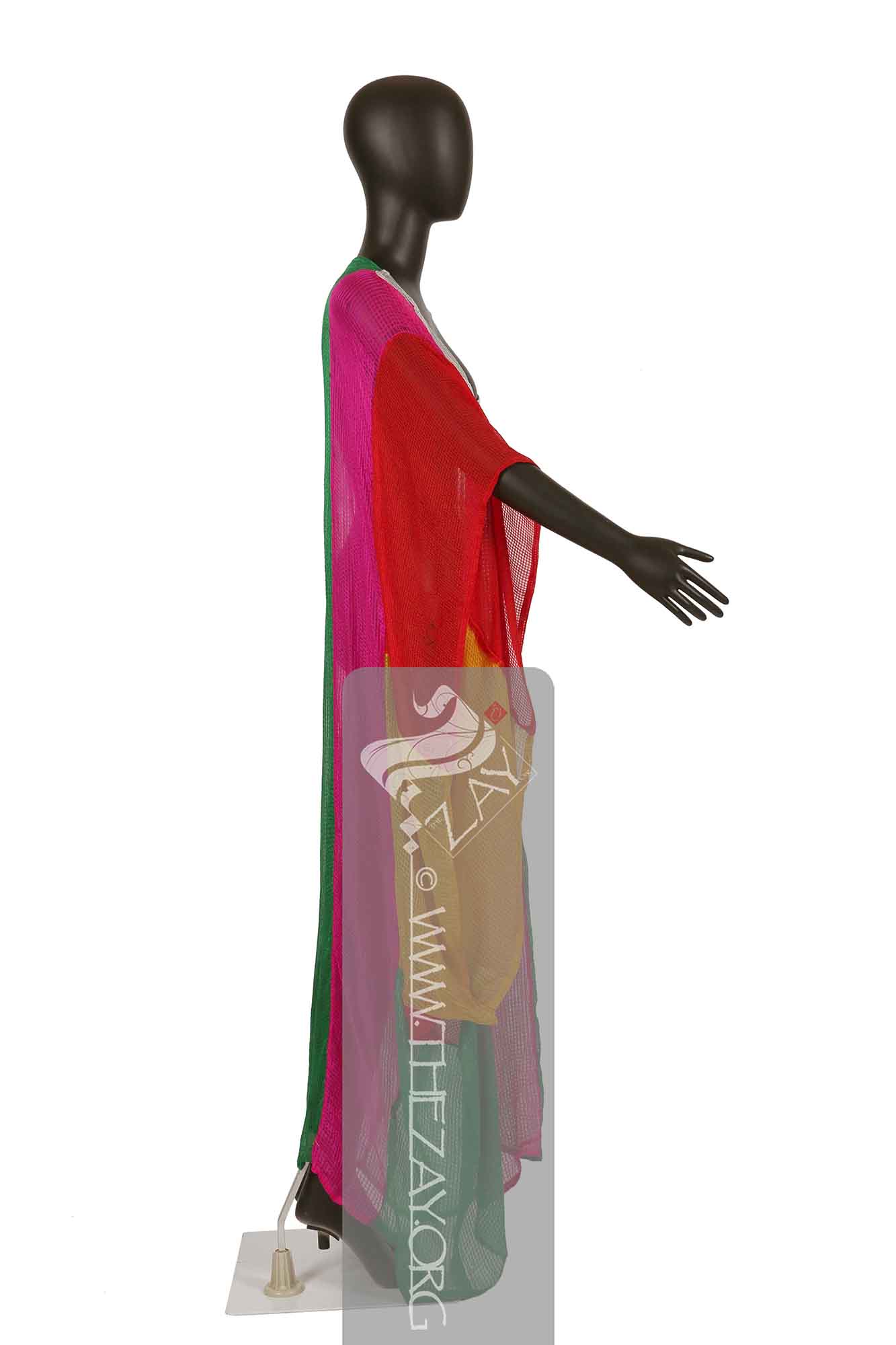
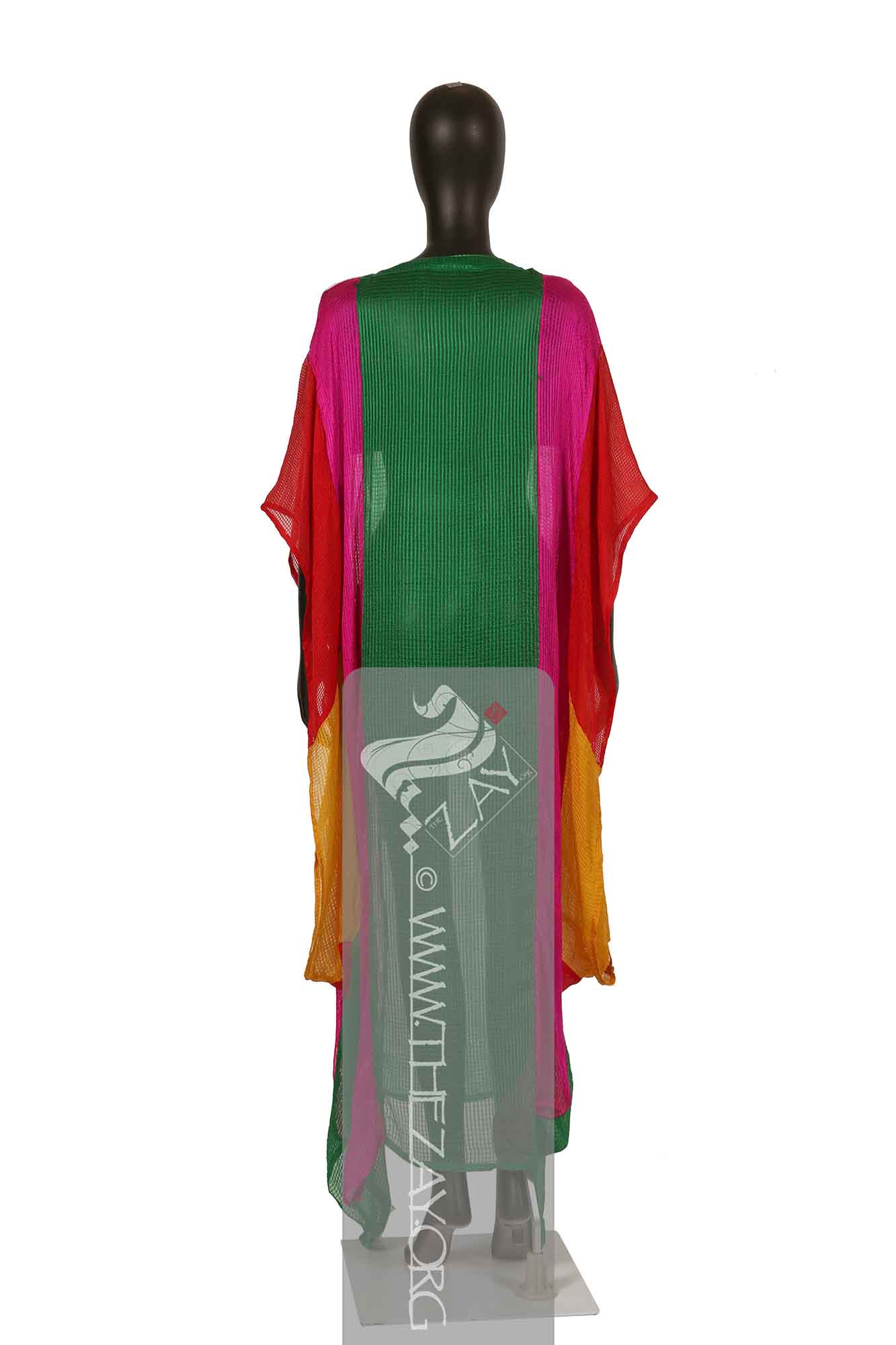
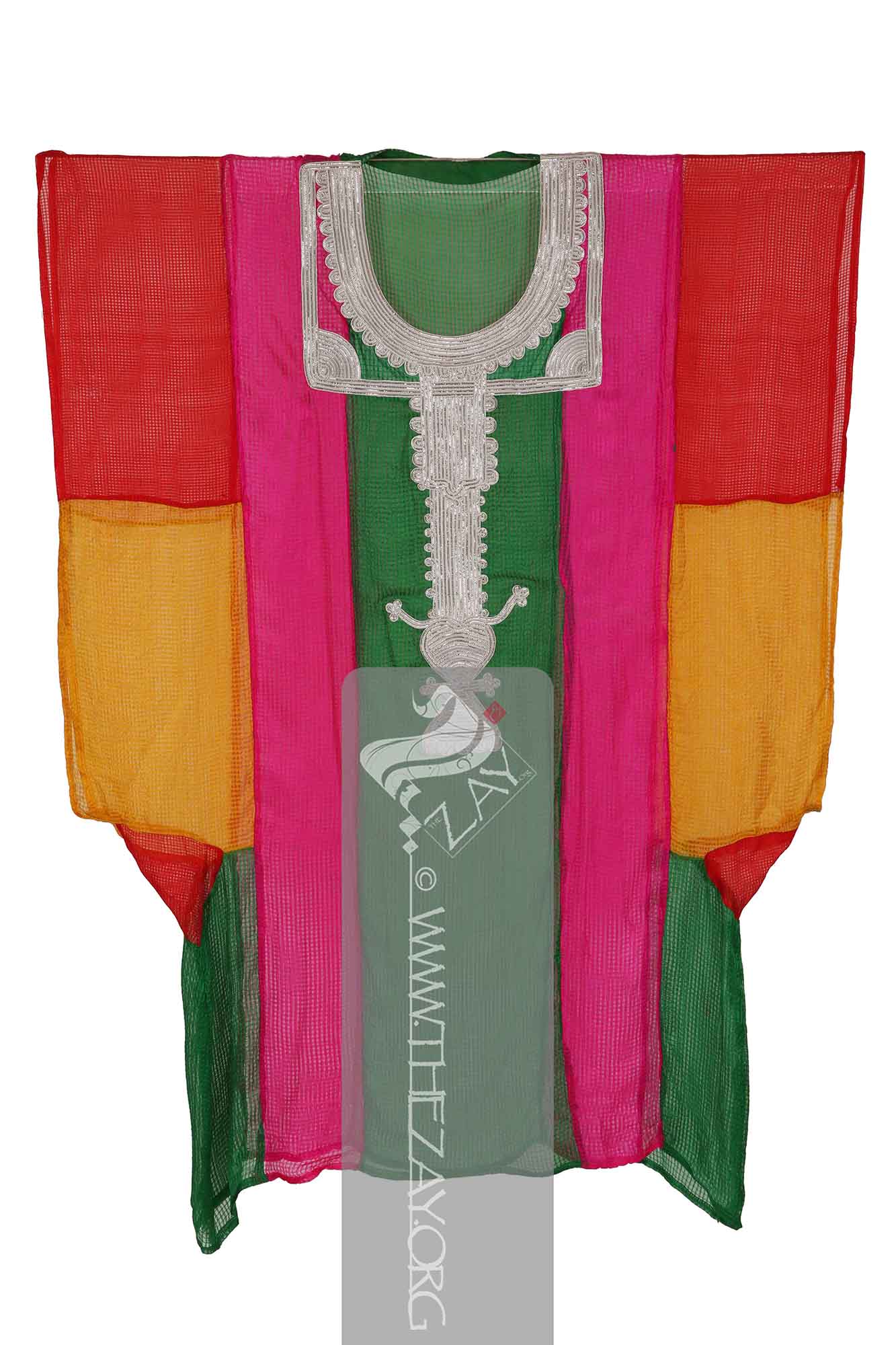
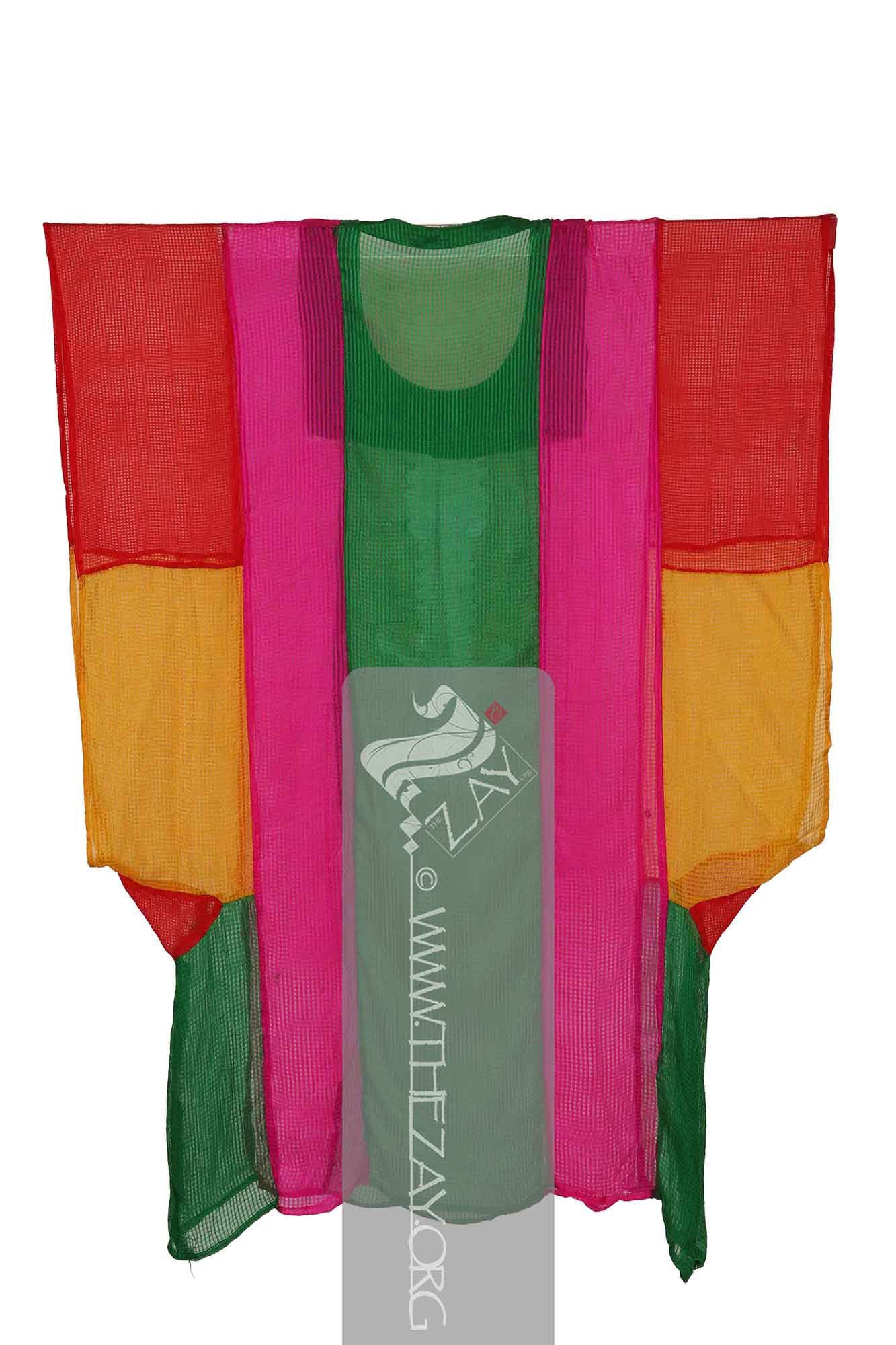

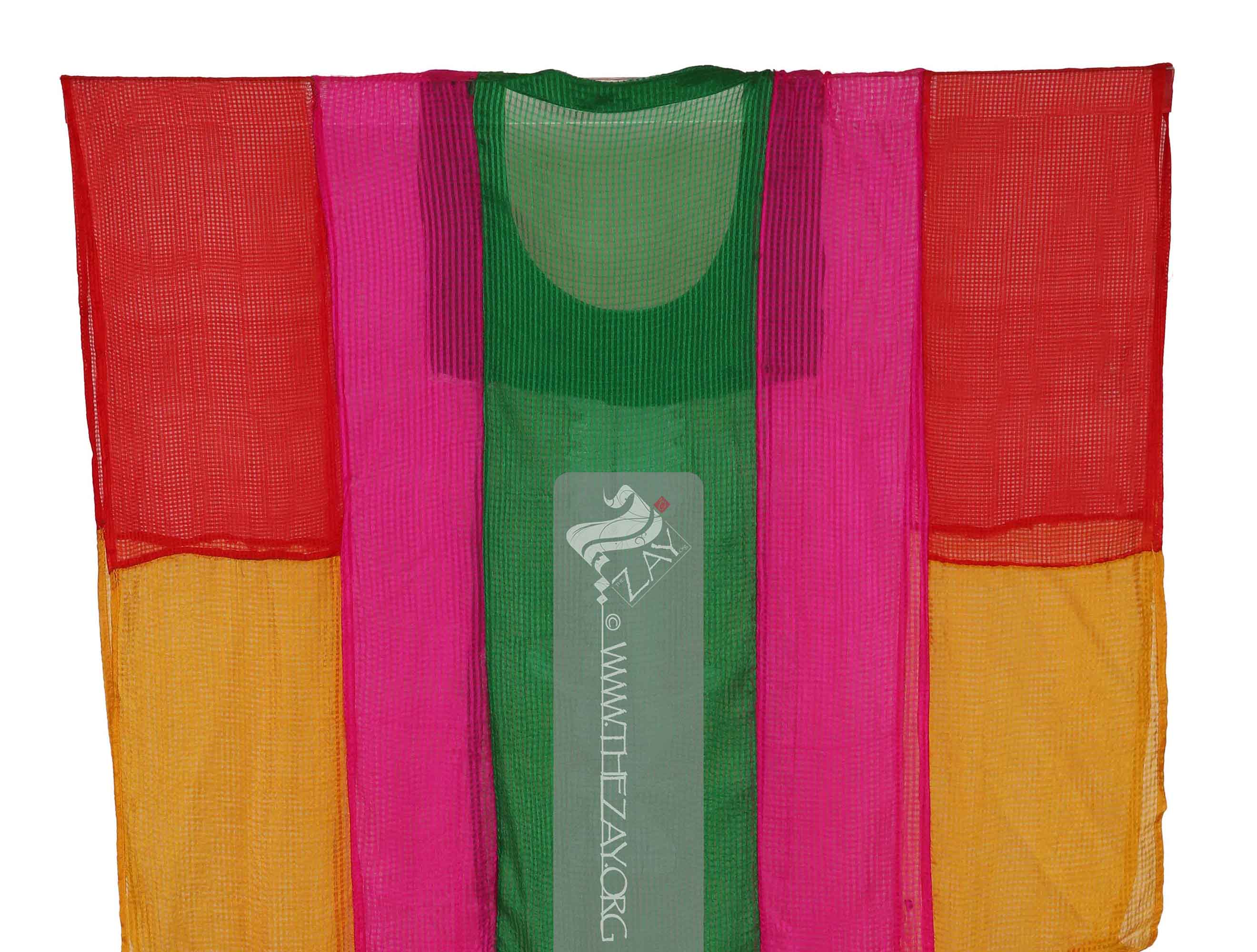

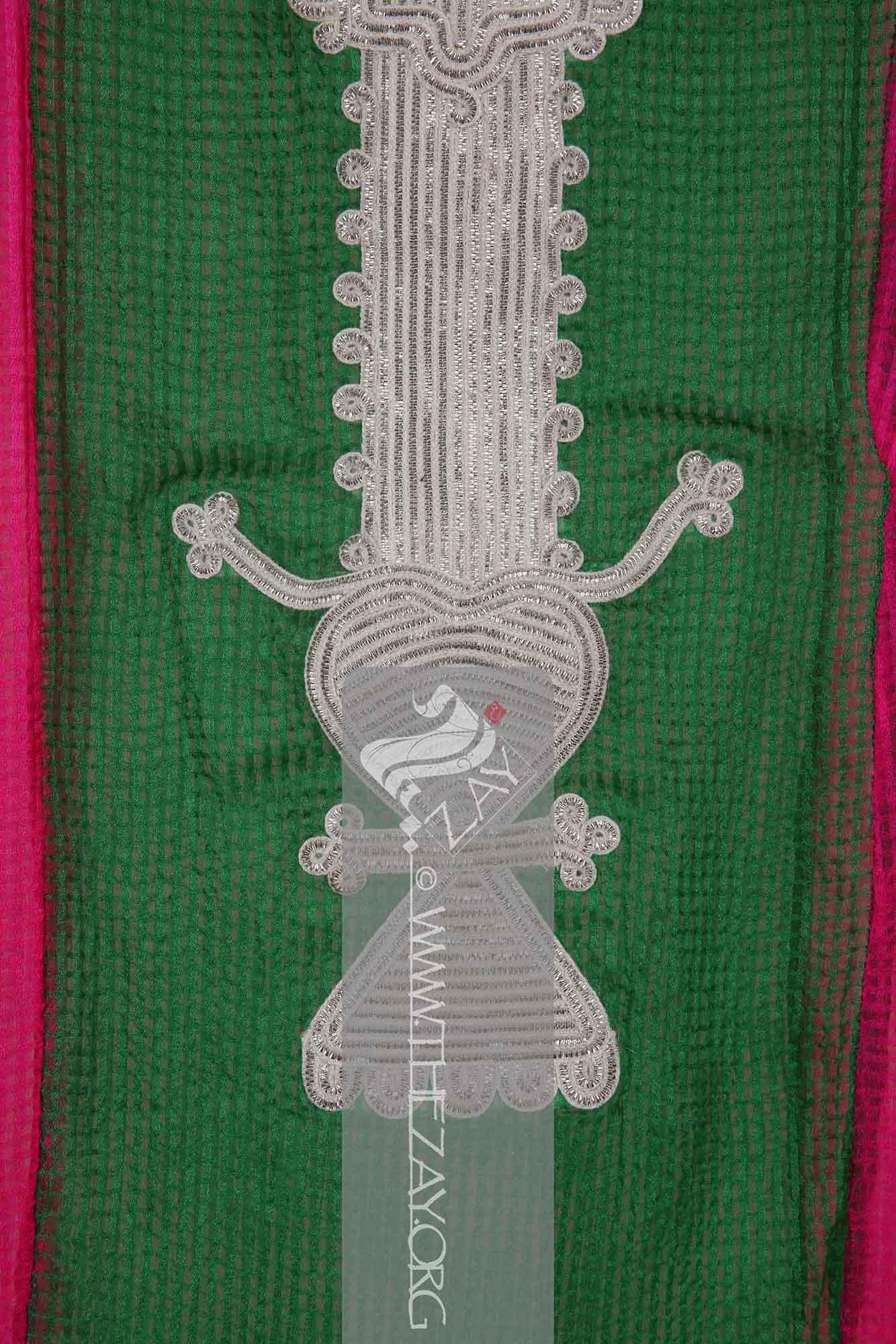

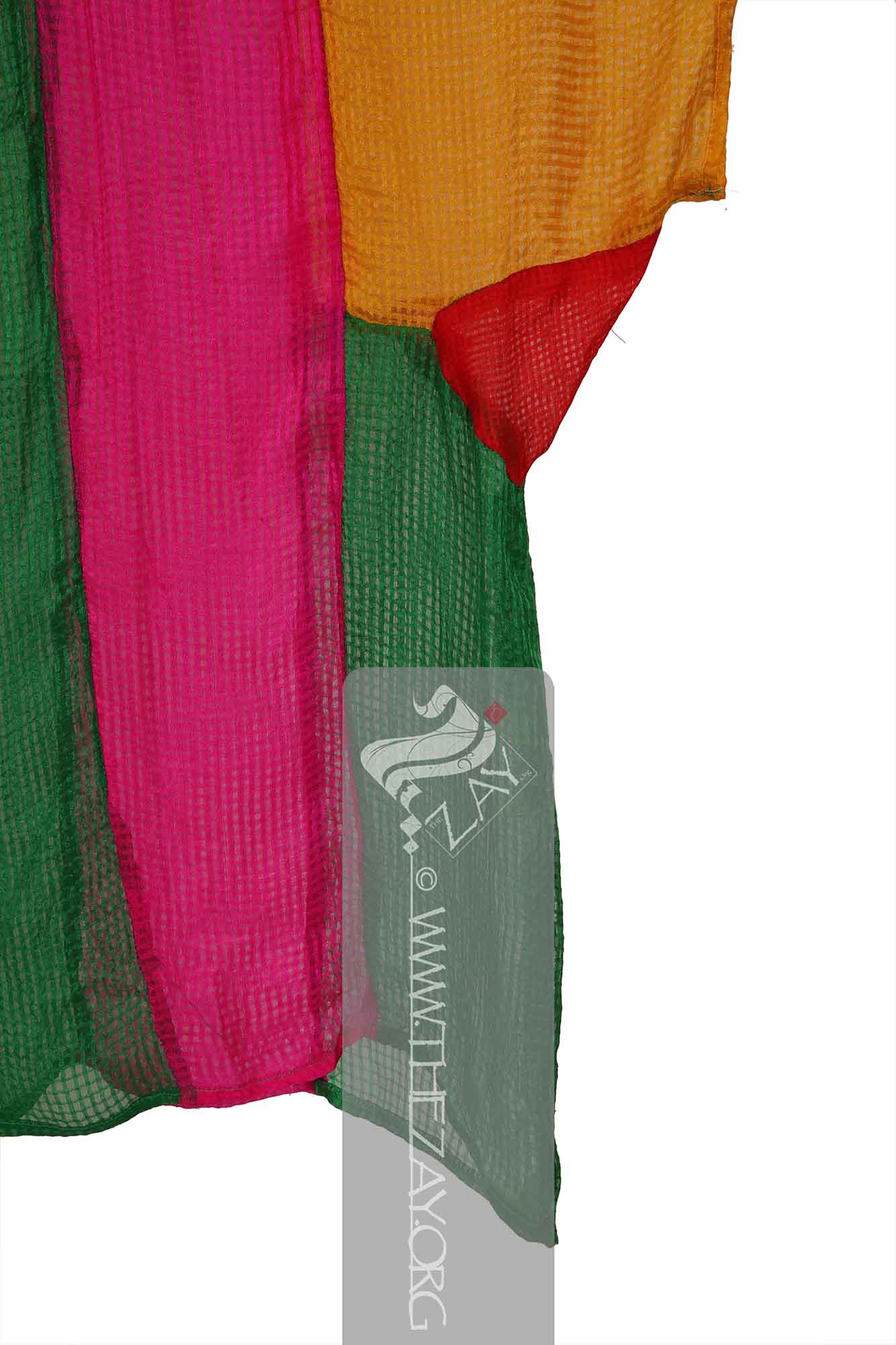
| Local Name | Thawb myaza’, khus zari, dharb talli |
| Object Category | Overgarment |
| Gender | Female |
| Date of object | 1995 |
| Place Of orgin | United Arab Emirates |
| Region | Al Ain |
| Object Range | United Arab Emirates |
| Dimensions | Length: 133 cm Width: 106 cm |
| Materials | Silk |
| Technique | Machine Stitched Embellished |
| Color | |
| Motif | Geometric |
| Provenance | Gifted, Hamdah Sultan, Um Thani, Al Ain 1995 |
| Location | The Zay Zay: (Arabic: costume, Pl. azyaā’), a set of clothes in a style typical of a particular country or historical period. Initiative |
| Status | In storage |
| ZI number | ZI1995.50026 UAE |
Ṭariq: (Arabic; Synonym: tulle_bi_talli; talli; badla; khus_dozi ), series of small metal knots made on a woven net ground as embellishment. The term is commonly used in the Levant Arab region specifically in Lebanon.
el Mutwalli Dr. Reem TariqṬariq: (Arabic; Synonym: tulle_bi_talli; talli; badla; khus_dozi ), series of small metal knots made on a woven net ground as embellishment. The term is commonly used in the Levant Arab region specifically in Lebanon.
el Mutwallī: Founder (CEO) of the Zay Zay: (Arabic: costume, Pl. azyaā’), a set of clothes in a style typical of a particular country or historical period. Initiative, a public figure, speaker and author. An expert curator and consultant in Islamic art and architecture, interior design, historic costume, and UAE heritage. was collecting data for her studies she met with Hamdah Sultan, Um ‘Um: (Arabic: mother), a sign of respect or formality, women are not addressed by their own names, rather as mother of, then adding the name of the eldest son as in Um Mohammed. Also can mean: with, for example (‘um mishakhiṣ) meaning with gold embellishment. Thani, who very generously gifted her this article.Tallī: (Turkish: tel – wire, string), Gulf Arab – a woven braided trimming made with metal wire, threads and ribbons often sewn on detachable panels used as embellishments. Other – (Synonym: tulle_bi_talli
Tūlle_bi_tallī: (French: Tulle – a city in France where fine material for veil was first made; Turkish: tel – wire; Synonym: tariq; talli; badla; khus_dozi
Khus_dozi: (Persian: Khvosh – an Iranian province; dozi – needlework; Synonym: tariq; talli; tulle_bi_talli; badla), series of small metal knots made on a woven net ground as embellishment. The term is commonly used in Iran and parts of the Arabian Peninsula possibly because Khvosh was one of the centres for the craft. Khus_dozi: (Persian: Khvosh – an Iranian province; dozi – needlework; Synonym: tariq; talli; tulle_bi_talli; badla), series of small metal knots made on a woven net ground as embellishment. The term is commonly used in Iran and parts of the Arabian Peninsula possibly because Khvosh was one of the centres for the craft.
Qamīṣ: (Possibly late Latin: Camisia – Linen Undergarment; Synonym: Kamiz), a traditional loose fitting long tunic or shirt worn by both men and women in South and Central Asia and the Arab world. Typically extending below the waist it is usually paired with a pair of trousers.
) tunic with frontal neckline opening, worn by both sexes. Each Arab region has a different term for what is essentially a similar garment with various small differences., qandurah Qandūrah: (Arabic, pl. qanādīr, synonyms: ghandurah Ghandūrah: (Arabic, pl. qanādīr, synonyms: qandurah, darā’ah, dishdāshah, jalābah, jallābīyah, qaftan, mqta’, thawb or tobe), a loose, short or long-sleeved, shirt like (qamisQamīṣ: (Possibly late Latin: Camisia – Linen Undergarment; Synonym: Kamiz), a traditional loose fitting long tunic or shirt worn by both men and women in South and Central Asia and the Arab world. Typically extending below the waist it is usually paired with a pair of trousers.
) tunic with frontal neckline opening, worn by both sexes. Each Arab region has a different term for what is essentially a similar garment with various small differences., darā’ah, dishdāshah, jalābah, jallābīyah, qaftan, mqta’, thawb or tobe Tobe: (Arabic: thawb, Pl. Athwāb/thībān), can be pronounced thawb or thobe based on locale. The standard Arabic word for ‘fabric’ or ‘garment’. It can refer to a qamīs-like tunic worn by men and women in the Arabian Peninsula, Iraq, the southern and south-western ports and islands of Iran, and some countries in East and West Africa. More specifically, it can refer to the square-shaped Bedouin overgarment worn by women. ), a loose, short or long-sleeved, shirt like (qamisQamīṣ: (Possibly late Latin: Camisia – Linen Undergarment; Synonym: Kamiz), a traditional loose fitting long tunic or shirt worn by both men and women in South and Central Asia and the Arab world. Typically extending below the waist it is usually paired with a pair of trousers.
) tunic with frontal neckline opening, worn by both sexes. Each Arab region has a different term for what is essentially a similar garment with various small differences. , dra’ah, dishdāshah, jallābīyah, jalābah, jillābīyah, qaftan, mqta’, thawb or tobe Tobe: (Arabic: thawb, Pl. Athwāb/thībān), can be pronounced thawb or thobe based on locale. The standard Arabic word for ‘fabric’ or ‘garment’. It can refer to a qamīs-like tunic worn by men and women in the Arabian Peninsula, Iraq, the southern and south-western ports and islands of Iran, and some countries in East and West Africa. More specifically, it can refer to the square-shaped Bedouin overgarment worn by women. ) loose, short or long sleeved, shirt like (qamisQamīṣ: (Possibly late Latin: Camisia – Linen Undergarment; Synonym: Kamiz), a traditional loose fitting long tunic or shirt worn by both men and women in South and Central Asia and the Arab world. Typically extending below the waist it is usually paired with a pair of trousers.
) tunic with frontal neckline opening, worn by both sexes. Each Arab region has a different term for what is essentially a similar garment with various small differences.) underneath, this overgarment is cut out of a loose weave, net-like, silk (bu_gafas Bū_gafāṣ: (Arabic: bū: diminutive of abū: father, gfāṣ: qafaṣ: cage), the term is used colloquially in the UAE to identify sheer, delicate wafer-thin malleable silk fabric, in mono-colour jacquard Jacquard: (After Joseph M Jacquard a French weaver and inventor), is referred to both an apparatus with perforated cards invented by the aforementioned Joseph M Jacquard in 1804 fitted to a loom enabling complex intricate weaving patterns and the brocaded fabric woven on a jacquard loom. fish-net weave, that creates intersecting lines, leaving areas of opaque and transparent mesh, resembling bars on a cage. Similar to (abdilhalīm) or (bū_smichah) and used mainly for overgarments (athwāb). Also pronounced (bū_gfaṣ), the letter (qāf) is turned to (ga) in Arab Gulf dialect.) fabric. The 40 cm green central panel (bdinah Bdinah: (Arabic: bdan Bdan: (Arabic: bdan: body, synonym: bdinah), generally refers to the central body panel on garments in most Arab Gulf dialect. : body, synonym: bdan Bdan: (Arabic: bdan: body, synonym: bdinah), generally refers to the central body panel on garments in most Arab Gulf dialect. ), generally refers to the central body panel on garments in most Arab Gulf dialect. ) is flanked by two vertical 20 cm wide fuchsia (busi Būṣī: (UAE colloquial), the colour fuschia.) panels (mfahah Mfaḥaḥ : (Arabic: faḥ: cut into pieces, pl. fḥūḥ, synonyms: myaraḥ, myaza’), panelled overgarment (thawb Thawb: (Arabic: thawb, Pl. Athwāb/thībān), can be pronounced thobe Thobe: (Arabic: thawb, Pl. Athwāb/thībān), can be pronounced thawb or tobe Tobe: (Arabic: thawb, Pl. Athwāb/thībān), can be pronounced thawb or thobe based on locale. The standard Arabic word for ‘fabric’ or ‘garment’. It can refer to a qamīs-like tunic worn by men and women in the Arabian Peninsula, Iraq, the southern and south-western ports and islands of Iran, and some countries in East and West Africa. More specifically, it can refer to the square-shaped Bedouin overgarment worn by women. based on locale. The standard Arabic word for ‘fabric’ or ‘garment’. It can also refer to a qamīs-like tunic worn by men and women in the Arabian Peninsula, Iraq, the southern and south-western ports and islands of Iran, and some countries in East and West Africa. More specifically, it can refer to the square-shaped Bedouin overgarment worn by women. or tobe Tobe: (Arabic: thawb, Pl. Athwāb/thībān), can be pronounced thawb or thobe based on locale. The standard Arabic word for ‘fabric’ or ‘garment’. It can refer to a qamīs-like tunic worn by men and women in the Arabian Peninsula, Iraq, the southern and south-western ports and islands of Iran, and some countries in East and West Africa. More specifically, it can refer to the square-shaped Bedouin overgarment worn by women. based on locale. The standard Arabic word for ‘fabric’ or ‘garment’. It can also refer to a qamīs-like tunic worn by men and women in the Arabian Peninsula, Iraq, the southern and south-western ports and islands of Iran, and some countries in East and West Africa. More specifically, it can refer to the square-shaped Bedouin overgarment worn by women in the Arabian Gulf region. ).) on each side. The wide sleeves (jinan Jinān: (Colloquial Arab Gulf, synonym: akmām, kmūm, chmūm), wide sleeve panels on overgarments (athwāb). ) are composed of three horizontal panels (myaza’), consecutively in red, yellow, and green. While red diamond gussets help the sleeves drape well.Tallī: (Turkish: tel – wire, string), Gulf Arab – a woven braided trimming made with metal wire, threads and ribbons often sewn on detachable panels used as embellishments. Other – (Synonym: tulle_bi_talli
Tūlle_bi_tallī: (French: Tulle – a city in France where fine material for veil was first made; Turkish: tel – wire; Synonym: tariq; talli; badla; khus_dozi
Khus_dozi: (Persian: Khvosh – an Iranian province; dozi – needlework; Synonym: tariq; talli; tulle_bi_talli; badla), series of small metal knots made on a woven net ground as embellishment. The term is commonly used in Iran and parts of the Arabian Peninsula possibly because Khvosh was one of the centres for the craft. Khus_dozi: (Persian: Khvosh – an Iranian province; dozi – needlework; Synonym: tariq; talli; tulle_bi_talli; badla), series of small metal knots made on a woven net ground as embellishment. The term is commonly used in Iran and parts of the Arabian Peninsula possibly because Khvosh was one of the centres for the craft.
Qamīṣ: (Possibly late Latin: Camisia – Linen Undergarment; Synonym: Kamiz), a traditional loose fitting long tunic or shirt worn by both men and women in South and Central Asia and the Arab world. Typically extending below the waist it is usually paired with a pair of trousers.
) tunic with frontal neckline opening, worn by both sexes. Each Arab region has a different term for what is essentially a similar garment with various small differences., qandurah Qandūrah: (Arabic, pl. qanādīr, synonyms: ghandurah Ghandūrah: (Arabic, pl. qanādīr, synonyms: qandurah, darā’ah, dishdāshah, jalābah, jallābīyah, qaftan, mqta’, thawb or tobe), a loose, short or long-sleeved, shirt like (qamisQamīṣ: (Possibly late Latin: Camisia – Linen Undergarment; Synonym: Kamiz), a traditional loose fitting long tunic or shirt worn by both men and women in South and Central Asia and the Arab world. Typically extending below the waist it is usually paired with a pair of trousers.
) tunic with frontal neckline opening, worn by both sexes. Each Arab region has a different term for what is essentially a similar garment with various small differences., darā’ah, dishdāshah, jalābah, jallābīyah, qaftan, mqta’, thawb or tobe Tobe: (Arabic: thawb, Pl. Athwāb/thībān), can be pronounced thawb or thobe based on locale. The standard Arabic word for ‘fabric’ or ‘garment’. It can refer to a qamīs-like tunic worn by men and women in the Arabian Peninsula, Iraq, the southern and south-western ports and islands of Iran, and some countries in East and West Africa. More specifically, it can refer to the square-shaped Bedouin overgarment worn by women. ), a loose, short or long-sleeved, shirt like (qamisQamīṣ: (Possibly late Latin: Camisia – Linen Undergarment; Synonym: Kamiz), a traditional loose fitting long tunic or shirt worn by both men and women in South and Central Asia and the Arab world. Typically extending below the waist it is usually paired with a pair of trousers.
) tunic with frontal neckline opening, worn by both sexes. Each Arab region has a different term for what is essentially a similar garment with various small differences. , dra’ah, dishdāshah, jallābīyah, jalābah, jillābīyah, qaftan, mqta’, thawb or tobe Tobe: (Arabic: thawb, Pl. Athwāb/thībān), can be pronounced thawb or thobe based on locale. The standard Arabic word for ‘fabric’ or ‘garment’. It can refer to a qamīs-like tunic worn by men and women in the Arabian Peninsula, Iraq, the southern and south-western ports and islands of Iran, and some countries in East and West Africa. More specifically, it can refer to the square-shaped Bedouin overgarment worn by women. ) loose, short or long sleeved, shirt like (qamisQamīṣ: (Possibly late Latin: Camisia – Linen Undergarment; Synonym: Kamiz), a traditional loose fitting long tunic or shirt worn by both men and women in South and Central Asia and the Arab world. Typically extending below the waist it is usually paired with a pair of trousers.
) tunic with frontal neckline opening, worn by both sexes. Each Arab region has a different term for what is essentially a similar garment with various small differences.) underneath to be visible. This in turn pushed the decorative heavy adornment work outwards, spilling over the shoulders and flowing down the upper sleeves. The length and width of the embroidered central axis of the thawb Thawb: (Arabic: thawb, Pl. Athwāb/thībān), can be pronounced thobe Thobe: (Arabic: thawb, Pl. Athwāb/thībān), can be pronounced thawb or tobe Tobe: (Arabic: thawb, Pl. Athwāb/thībān), can be pronounced thawb or thobe based on locale. The standard Arabic word for ‘fabric’ or ‘garment’. It can refer to a qamīs-like tunic worn by men and women in the Arabian Peninsula, Iraq, the southern and south-western ports and islands of Iran, and some countries in East and West Africa. More specifically, it can refer to the square-shaped Bedouin overgarment worn by women. based on locale. The standard Arabic word for ‘fabric’ or ‘garment’. It can also refer to a qamīs-like tunic worn by men and women in the Arabian Peninsula, Iraq, the southern and south-western ports and islands of Iran, and some countries in East and West Africa. More specifically, it can refer to the square-shaped Bedouin overgarment worn by women. or tobe Tobe: (Arabic: thawb, Pl. Athwāb/thībān), can be pronounced thawb or thobe based on locale. The standard Arabic word for ‘fabric’ or ‘garment’. It can refer to a qamīs-like tunic worn by men and women in the Arabian Peninsula, Iraq, the southern and south-western ports and islands of Iran, and some countries in East and West Africa. More specifically, it can refer to the square-shaped Bedouin overgarment worn by women. based on locale. The standard Arabic word for ‘fabric’ or ‘garment’. It can also refer to a qamīs-like tunic worn by men and women in the Arabian Peninsula, Iraq, the southern and south-western ports and islands of Iran, and some countries in East and West Africa. More specifically, it can refer to the square-shaped Bedouin overgarment worn by women in the Arabian Gulf region. also became more exaggerated and elaborate over time.